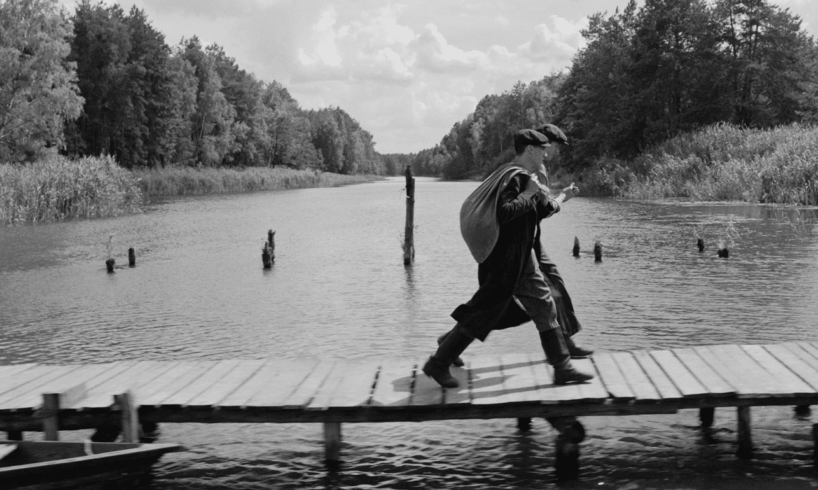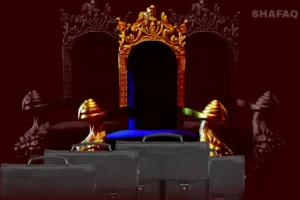
Ady Walter may have the most chutzpah of any Jewish director in recent years.
His new film “Shttl” is an audacious feat by any measure. Shot in 2021 in Ukraine — in a single take, in black and white, entirely in Yiddish, and during the height of COVID-19 restrictions — it was produced under the looming threat of a Russian invasion. Even more impressively, the entire movie was designed to look like one continuous take. To achieve this, Walter built a life-sized replica of a shtetl from the ground up, complete with homes, a synagogue, and winding dirt roads.
For his protagonist, Walter cast Moshe Lobel, a newcomer who had never before played a leading role in a feature film.
“The story of the film was a Jewish ‘Apocalypse Now,’” Walter told Unpacked. “This was a crazy adventure in wild conditions. We even shot in swamps with mosquitoes in Ukraine. With Moshe, I never met him before he came, but we had conversations over the phone where I could trust he was right for it.”
Why did “Shttl” have to be in Yiddish?
From the very beginning, Ady Walter knew “Shttl” could only be told in one language — Yiddish. Even if that choice meant the film would be less commercial, he refused to compromise on authenticity.
“I don’t come from a Yiddish-speaking family,” Walter said. “But not doing it in Yiddish wasn’t an option. I wanted to make a film where people spoke Yiddish because it was their language at the time. Otherwise, it wouldn’t have made sense.”
Walter’s commitment went beyond linguistic accuracy — it was about resurrecting a lost world. Though Yiddish is still spoken today in some Hasidic and Haredi communities, it is no longer the everyday language of most Jews, as it was in Eastern Europe before the Holocaust. To ensure historical fidelity, Walter and his team meticulously researched the dialect that would have been spoken in 1941 Ukraine, consulting linguists and cultural historians to capture its unique regional inflections and rhythms.
For Walter, every syllable of Yiddish in “Shttl” carries weight — not just as dialogue, but as memory. The language becomes a bridge to the vanished world he rebuilt on screen, giving voice once more to a people whose stories, songs, and prayers were nearly silenced.
Life in the shtetl
“Shttl” unfolds on June 21, 1941, the eve of the Nazi invasion of the Soviet Union, known as Operation Barbarossa. Within 24 hours, the world of its characters will vanish.
Antoine Millet as Folie has beef with Mendele, played by Moshe Lobel.
The story centers on Mendele, a charming young man who left his shtetl years earlier to pursue a career as a filmmaker in Kiev. Now, he returns home on the day before his former love, Yuna, is set to marry his old friend — and now rival — Folie, a local butcher who has become a rabbi.
As the day unfolds, the film asks a series of unspoken questions: Will Mendele reconcile with his estranged father? Will he try to stop the wedding? And what truly brought him back? The villagers and the audience wait in suspense to find out.
Lobel’s performance anchors the film. He captures Mendele’s mix of swagger and sensitivity, his confidence undercut by vulnerability, fear, frustration, and youthful naiveté. Through him, the film explores the tensions running through the shtetl: faith versus work, tradition versus modernity, exile versus belonging.
In one powerful scene, Mendele tells the townspeople that one can believe in the Torah and still work, a radical notion for some in the community. Others dream of leaving for British Mandate Palestine, while some insist they must stay and await the Messiah. In this divided world, “Shttl” becomes more than a historical drama — it’s a haunting portrait of a civilization on the brink, unaware that its final day has already begun.
Moshe Lobel’s Personal Journey Into “Shttl”
Lobel is so masterful in his role that it’s hard to believe he ever had doubts about himself. Before “Shttl,” his résumé included only a small part in the horror film “The Vigil” and an audition for the role of Perchik in the Yiddish “Fiddler on the Roof” in Manhattan. He didn’t get the part — instead, he was cast as the badchan, or wedding jester, and innkeeper. He took the role on the advice of his mother, who reminded him he’d be crazy not to work with Joel Grey.
When it came to “Shttl,” Walter cast him as the lead without so much as an audition, a decision Lobel later admitted was for the best, confessing he doesn’t really excel at them.
Filming was originally scheduled for the summer of 2020, but the pandemic put everything on hold. “I sat at home for a year, not knowing if the world would resume, also waiting for them to find a star to replace me,” Lobell recalled. That kind of imposter syndrome kicked in.”
At night, Moshe, Yuna (Anisa Stasevich) and Demyan (Petro Ninovski) ponder the future.
Once shooting finally began — an intense, seven-week production in the Ukrainian countryside — those fears faded. The experience, he said, was transformative: “I couldn’t imagine myself without the film or the film without me.”
One of the film’s most poignant moments comes when Mendele tells his father that he no longer truly hears him, a confrontation layered with love, pain, and disconnection. For Lobel, the scene hit especially close to home.
In real life, Lobel left the Satmar Hasidic community in Brooklyn when he was around 12 years old. His decision led to a deep rupture with his family, and he has not spoken to his father since.
“The script was written a few years before Ady knew I existed, but there were a lot of similarities with the character and my life,” Lobel said. “I could understand his struggles very well and used the character’s experience to understand my own relationships better. I did bring a couple of things from my own life to the film, most notably the singing scene in the synagogue. That moment wasn’t in the script originally.”
The singing scene in the synagogue, for instance, was not part of the original script — it came directly from his own memories. Trained as a chazzan (cantor) as a child, Lobel suggested including a moment where Mendele sings a melody from Kabbalat Shabbat, one he used to lead in his synagogue in Borough Park. The quiet, spiritual intimacy of that scene became one of the film’s most moving sequences, a bridge between the actor’s past and his art.
“War is coming’
“Shttl” is filled with haunting lines that echo far beyond its setting. One villager — dismissed by others as a fool — recalls a dream in which the Red Sea collapses on everyone. Another chilling moment comes when Mendele warns, “War is coming.” The question lingers: Did the Jews of the shtetls in 1941 truly understand what was about to descend upon them?
“There was a lot of talk of what might come,” Lobel explained. “Some even thought the Nazis might alleviate the brutal tactics of the Soviets. They heard rumors and things, but didn’t truly understand. It’s difficult to know, and there was a lot of debate about what would happen. At the end of the day, people had to worry about their chickens and how to put bread on the table.”
That sense of denial and everyday preoccupation, Lobel noted, feels eerily familiar today. Many Ukrainians, he pointed out, also didn’t believe Russia would invade in 2022.
Saul Rubinek as the rabbi, stares at Lobel, who plays Moshe, trying to explain his thoughts.
The parallels give “Shttl” an uncanny resonance. Lobel’s scenes with veteran actor Saul Rubinek, who plays the town rabbi, are among the film’s most powerful. Their arguments over faith, doubt, and unity crackle with intensity, revealing two men grappling with uncertainty in a world about to shatter.
The film’s black-and-white cinematography only heightens the tension, each frame thick with foreboding, every flicker of light suggesting both holiness and loss.
The toughest scenes to shoot
In “Shttl,” Mendele’s mother has already passed away when the story begins. But a flashback sequence brings her briefly back to life — a moment that Lobel found particularly difficult to film.
He explained that, although his own mother is alive and well, she endured societal pressures similar to those faced by his character’s mother.
The film’s final scene proved even more grueling. In it, Mendele reaches a breaking point — emotionally and physically shattered by what he’s witnessed. “It almost felt like a real trauma,” Lobel recalled.
Saul Rubinek as the rabbi
For Walter, another scene stands out: the final gathering in the synagogue. It begins with a close-up of Yuna’s eyes, glimpsed from behind the mechitza — the divider separating men and women. The camera lingers just long enough for viewers to wonder if she’s still hoping for reconciliation with Mendele.
Walter, who keeps Shabbat, follows kosher observance, and remains close to his rabbi in his Paris community, said this moment carried profound emotional weight for him.
“I put my own kids in the scene, and when I shot that, I took the measure of what has been lost forever,” Walter said. “That scene was hard and humbling. It’s the last time everyone goes to the shul together. When I shot that, it was intimate and difficult. I will never recover from that. It was an intense feeling of loss. The shtetl is gone forever.”
Preserving the memory of the Holocaust
It’s nearly impossible to watch “Shttl” — a story about a Jewish community unaware that it’s living its final day — without thinking about modern tragedies. Some viewers have drawn parallels to October 7, noting the similar sense of safety shattered in an instant.
Walter, however, resists that comparison. “I am wary of any attempt at political appropriation of the Shoah,” he said. “It shows a lack of respect for the singularity of this event in human history. We don’t have the right to make the dead speak. The people of the shtetl died brutally, without knowing anything about the worlds to come.”
For Walter, the film’s enduring questions lie elsewhere: faith, loyalty, and betrayal. “Would you stay true to the religion of your fathers?” he asked. “Are you betraying something if you become someone your family doesn’t expect? Those were questions then — and they’re questions now.”
He also noted one deliberate artistic choice: the Nazis are never shown.
Why “Shttl” is an instant classic
It’s no surprise that “Shttl” won the Audience Award at the Rome Film Festival. The film is a cinematic triumph — anchored by stellar performances, precise pacing, and a narrative that builds tension without ever turning preachy. It’s a high-wire act without a safety net, and not once does it falter.
The ensemble’s chemistry is electric. Lobel and Antoine Millet, who plays Folie, make it entirely believable that they were once Talmudic study partners and are now bitter enemies. Despite limited screen time together, Mendele and Yuna (Anisa Stasevich) convey a deep, enduring connection — one that feels strong enough to risk everything for.
Mendele’s scenes with his father, who delivers a startling confession, and those with the rabbi highlight the character’s balance of reverence and rebellion. These moments give the film its emotional weight and moral complexity.
“Shttl” feels like being dropped out of a time machine into a vanished world. The few flashbacks rendered in color are striking — though one more might have offered a deeper glimpse into Mendele’s mother. Courageous and harrowing, the film is a testament to Walter’s daring vision. It’s both emotionally shattering and profoundly alive.
The title itself — spelled without the “e,” inspired by the 1969 French novel “La Disparition” (which famously omits that letter) — is a subtle act of artistic defiance. “Shttl” stands out as a rare Holocaust-related film that centers on the living Jew, not the murdered one, preserving, with beauty and sorrow, the final heartbeat of a world about to disappear.





